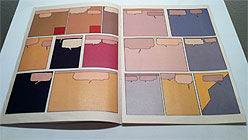Upon walking through the doors of the Mills College Art Museum, all I could say was, “YES!” Piles of junk, painted walls, and big sculptures greeted me, and it was clear that this year’s crop of artists would maintain the legacy of the solid work we covered at Mills’ MFA shows in 2009 and last year. The museum is grand and calls for art that measures up and fills the space, and the newly minted 2012 grads did their job. Their exhibition is titled The Last Show on Earth, and if it actually was, that would be OK by me.
I was on a mission to select a few favorites, but narrowing was a challenge. The mini solo exhibits gelled perfectly as one show, each artist in conversation with the next. Jocelyn Maggait’s Free: A Utopian Project was the aforementioned pile of junk, which is what it looked like at first glance. This makeshift store of objects was culled from the free section on Craigslist, then curated and stacked together in poignant, aesthetically pleasing piles of handled objects, many of which had a creative bent. The artist invited her audience to take something home and consider the history of the object. I scored a plastic hot dog bun for my fake food collection and wondered how many children or animals had slobbered on it since 1987, which was the production date stamped on the bottom.
Sofia Sharpe‘s work focused on tools of the trade, highlighting their colorful beauty and playfulness as objects in both painting and sculptural form. Tressa Pack also isolated her tools, anthropomorphizing lamps and photo equipment by staging them outdoors, crowded together around unseen subjects. Her photos were arresting and mysterious and I felt like I could walk right into the largest one.
This group of artists experimented with video like it was a new toy; nearly every artist used it in distinct and clever ways. Camilla Newhagen, creator of the tallest piece in the show (an enormous, clothing-strewn sculpture), made stop-motion videos of clothes being tossed into a heap. Side-by-side, the two monitors looked like perfectly framed digital paintings. Newhagen is an elegant problem solver dealing with the fragility of structures built by accumulation.


